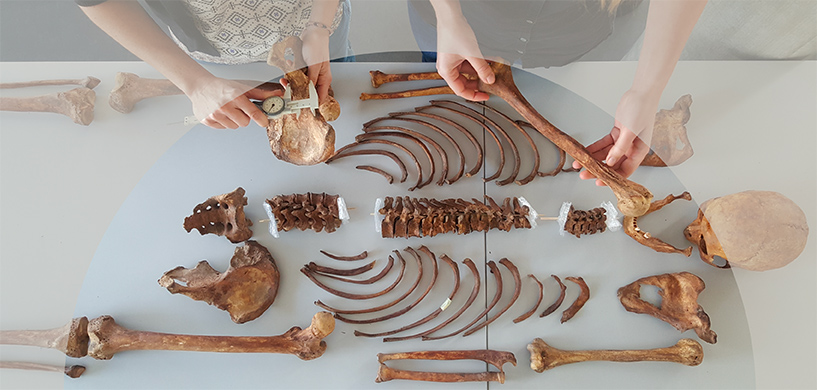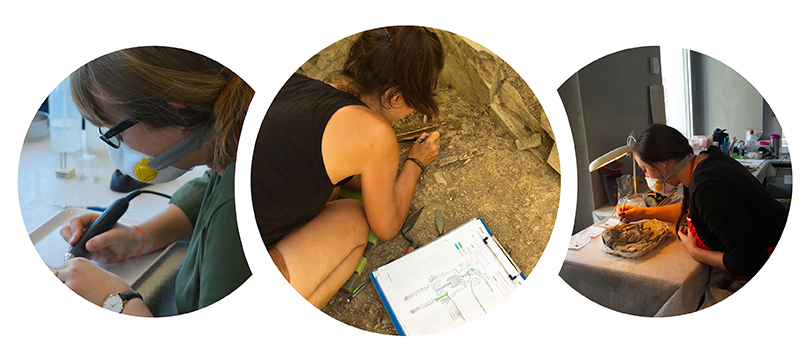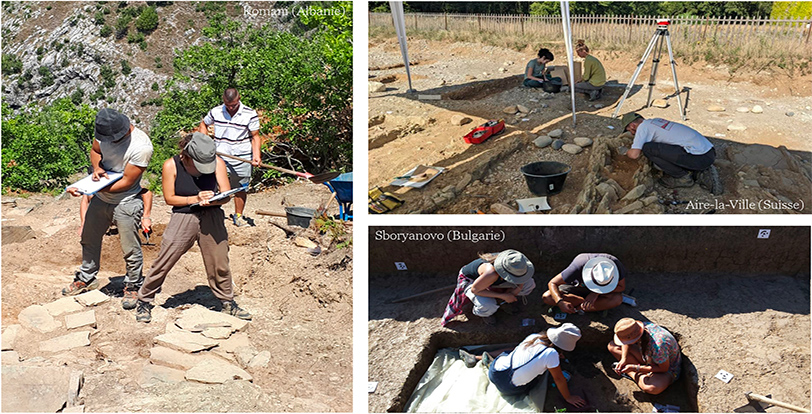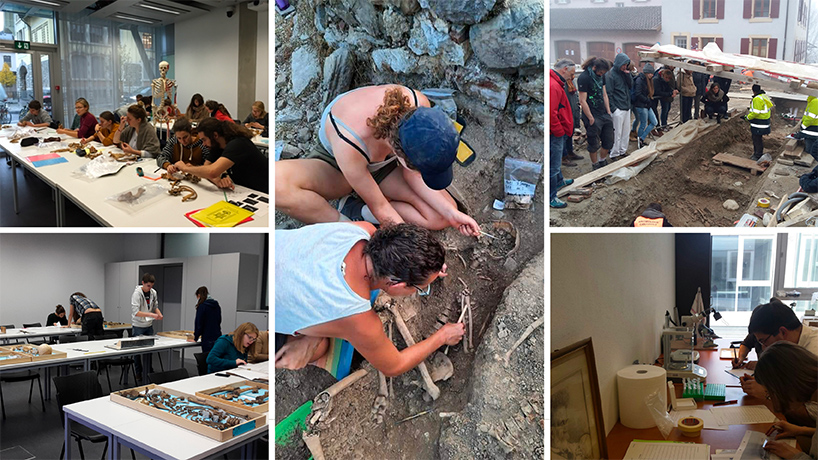Bioanthropology
BIOANTHROPOLOGY

Bioanthropology aims to identify the history and behaviour of past populations based on human bone remains. A number of themes can be addressed through this approach: funerary recruitment, health status, activities, biological proximity between individuals or populations, diet, personal mobility, socio-economic functioning, etc.
Part of the ARCAN laboratory team is currently involved in various bioanthropology research projects. The main areas of research concern field anthropology (archaeothanatology), biological identity (sex and age at death), epigenetic traits, isotopic biogeochemistry, palaeopathology and the study of cremations.

Research projects in progress
In search of the first Alpine agro-pastoral societies through the analysis of food practices, lifestyles and settlement dynamics: a renewed vision
(subside FNS 10521F-205059 / 2022-2025)
https://data.snf.ch/grants/grant/205059
This research project concerns a period of prehistory, the Neolithic, which developed between 5500 and 2200 BC in western Switzerland and saw major changes in the way its societies lived and functioned. These were the first agro-pastoral communities. The project will decipher their eating habits, lifestyles and mobility, using interdisciplinary methods of investigation.
The first part of the project aims to analyse changes in diets and subsistence practices. The results of two approaches will be mobilised: an isotopic geochemical approach, and a palaeopathological approach to assess the overall state of health through environmental damage and bio-cultural markers. The second part of the project aims to reconstruct the history of the settlement, by studying the mobility of individuals throughout the Neolithic period. To do this, the results of three approaches will be pooled: the isotopic geochemical approach, the study of dental epigenetic variations and palaeogenomics.
This project focuses on the canton of Valais, which has produced some remarkable human occupations between the Middle Neolithic and the Campaniform periods. The funerary finds are significant, both in terms of quality and number. This situation, which is extremely rare and precious in archaeology, will enable us to work on populations from a defined territory and spread over a chronological period without any major hiatus. More than 350 individuals will be studied, including some of the most important and unpublished sites of the Helvetic Neolithic (Petit-Chasseur, Don Bosco, etc.).
Sboryanovo (Bulgaria) - Necropolises and territory
(FSLA grant / 2018-2022)
https://www.unine.ch/ia/home/projets-de-recherche/sboryanovo-bulgarie.html
The Sboryanovo archaeological reserve in north-east Bulgaria covers an exceptionally rich area of almost 800 hectares, bearing witness to the existence of a major political, economic and religious centre during the Second Iron Age. The complex unearthed includes an urban centre, sanctuaries and necropolises with over a hundred burial mounds, some of which yielded extremely rich tombs.
Since 2014, a Bulgarian-Swiss mission, including bioanthropologists from the ARCAN laboratory, has been carrying out interdisciplinary archaeological research there. The data collected represents the largest series of remains from an aristocratic funerary context in Bulgaria - and the Balkans in general - from the 4th-3rd centuries BC. More specifically, the programme aims to characterise, in the broadest sense of the term, the funerary occupation of this area. It involves re-examining previous excavations and acquiring new data by applying and developing interdisciplinary methods of investigation in the field and in the laboratory.
The Drin Valley in the Middle Ages: study of the common necropolis of the medieval town of Komani (Albania)
(SACAD grant / 2019-2022)
https://www.efrome.it/la-recherche/archeologie/komani-albanie
The medieval town of Komani is located in the Drin Valley in northern Albania. The excavation of this site is at the heart of an international and interdisciplinary research programme: The Drin Valley in the Middle Ages. The aim of this programme is to explore the dynamics of the formation and functioning of medieval societies in the Balkan Mediterranean world, through the study of settlement and habitat and the analysis of production and trade in this region of western Illyricum, the crossroads of the south-east Adriatic.
Since 2017, bioanthropologists from the ARCAN laboratory have been working on the programme, studying the necropolises and associated burial areas of the medieval towns included in the programme by acquiring new data in the field and re-examining earlier excavations (1961 and 1982/1984). The team is currently carrying out research on the common necropolis of the medieval town of Komani with a view to excavating, studying and scientifically exploiting the funerary area.
The Merovingian necropolis at Aire-la-Ville (Switzerland) (OPS/SCA)
https://www.ge.ch/dossier/archeologie-genevoise
A Merovingian necropolis was unearthed in the Geneva countryside, at Aire-la-Ville, in the early summer of 2022. An unscheduled rescue excavation was quickly set up by Geneva's cantonal archaeology department, in collaboration with bioanthropologists from the ARCAN laboratory and students from the University of Geneva. More than twenty burials were excavated, including nine trunk burials and thirteen pit burials, which were suspected to have been constructed from perishable materials.
The collaboration between the cantonal archaeology service and the ARCAN laboratory is continuing. Various studies are currently underway, which will help to clarify the funerary practices and rituals of this Merovingian burial area.

What we teach
The teaching of bioanthropology (or palaeoanthropology) is also one of the strengths of the ARCAN laboratory. An initial Bachelor's-level course introduces students studying prehistoric archaeology to the study of funerary worlds, starting with an introduction to the study of ancient human remains. This course includes an in-depth study of human osteology, the acquisition of methods for determining biological identity and an introduction to the study of ancient populations. A practical application through the study of an archaeological series brings this initial learning to a close. Master's-level teaching enables students to deepen their knowledge. This is a block course presenting the methods used in bioanthropology to approach the history of ancient populations (funerary recruitment, health status, activities, diet, mobility, etc.). A theme related to the course is developed during the seminar. Occasional lectures in other courses complete the introduction to bioanthropology as part of the training of prehistoric archaeologists.
Field placements and laboratory placements are regularly offered to students wishing to study the funerary world at both Bachelor's and Master's level. Field placements enable students to familiarise themselves with the practical study of different funerary structures: understanding the different stages involved, excavation and data recording techniques, and the processing of remains, sediments and documentation. During the laboratory placements, they join a research team or institution (university, museum, cantonal archaeology, archaeology service or ARCAN laboratory) to discover and practise the various facets of the bioanthropology profession.

All these courses can be taken by students from other universities wishing to learn the basics of the discipline. Thanks to the Triangle Azur programme, students from the universities of Neuchâtel and Lausanne can easily validate ECTS credits in their course and obtain assistance with travel expenses (for more information: https://www.triangle-azur.ch).
Students wishing to specialise in bioanthropology also have the opportunity to continue their learning through bachelor's and master's theses, as well as doctoral dissertations, supervised by specialists from the ARCAN laboratory.
The ARCAN laboratory occasionally welcomes bioanthropology trainees from a wide range of backgrounds.
Activities for the community
The return to the city is an important element. Individual or group events, mainly for primary schools, cycles or colleges, are regularly organised to present the profession of bioanthropologist.

What's more, the topics addressed by the laboratory's bioanthropologists are of interest to people beyond the scientific world, as they are to our societies. Diet, health, lifestyles and the mobility of individuals within a community are all topical concerns. As a result, the ARCAN laboratory's bioanthropologists also take part in public lecture series and appear in the media to present the results of their research.
